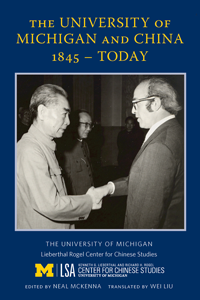
The University of Michigan and China 1845-Today
Skip other details (including permanent urls, DOI, citation information): This work is licensed under a Creative Commons Attribution-NonCommercial-NoDerivatives 3.0 License. Please contact [email protected] to use this work in a way not covered by the license.
For more information, read Michigan Publishing's access and usage policy.
Michigan and China: The Late Twentieth Century
In an effort to capture a record of this time of increased relations between the two nations, Professor Alexander Eckstein and Professor Michel Oksenberg helped establish the University of Michigan National Archive on Sino-American Relations, a historical collection documenting the informal relations between China and the United States between 1971 and 1980. This collection is -housed at the university’s Bentley Historical Library.
The visits and collaboration during the 1970s and 1980s marked the beginning of a series of high-level academic exchanges between China and the university. In 1979, Michigan psychologist Harold Stevenson invited the first Chinese psychologists to visit the United States since the Cultural Revolution. This visit resulted in the establishment of the Collaborative Research Center at the Institute of Psychology of the Chinese Academy of Sciences, which has fostered decades of continued collaborative research. On behalf of the American Council of Learned Societies and the Social Science Research Council, Don Munro led another group of university educators to China in 1979, the end product of which was a report on the status of the humanities and social sciences at major Chinese universities.
In 1979, members of the Chinese Academy of Social Sciences were invited to Ann Arbor for a visit. Two years later, former U-M President Harold Shapiro led a delegation to China at the invitation of the Chinese Minister of Education and signed an agreement of exchange and cooperation with ten major Chinese research institutions. The following year, a delegation of Chinese archivists visited the United States and included the University of Michigan as one of their stops.
The close relationship between China and the university continued to grow in the 1990s. A number of exchange programs were established in various academic units, expanding to, among others, the School of Business, the College of Engineering, and the School of Nursing. Former U-M President James Duderstadt led another delegation to China in 1993, and Chinese students continued to enroll at the University of Michigan for study and research.

Another director of the Center for Chinese Studies at the University of Michigan, Professor Kenneth Lieberthal, was appointed special assistant to President Bill Clinton and Director for Asian Affairs at the National Security Council. During his tenure, the relationship between the United States and China entered a new stage, as the two nations pledged to build a “constructive strategic partnership.”
The first Chinese students enrolled at the University of Michigan in 1892. The relationship between China and U-M was interrupted by the Sino-Japanese War and World War II, and then by the political complications between the United States and China, but since 1979, thousands of Chinese and Taiwanese students have enrolled at the university. For the first time since the 1920s, the University of Michigan once again enjoys one of the highest numbers of Chinese students on a single U.S. campus. In recent years, about 48 -percent of all international students at the University of Michigan have been from China and Taiwan, with over 3,000 enrolled in the 2015–2016 academic year.


